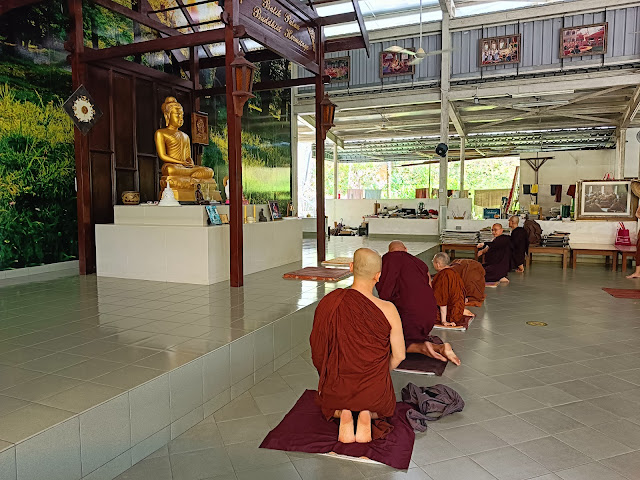Let's face it; we are not getting any younger. So when I say that my wife and I experienced an exhausting 11 hours on the road today, accompanying the monks and committee members of the Nandaka Vihara Meditation Society, I really meant it. However, I must add that these interactive hours that we spent in their company were the most exhilarating as well. They were some of the most enjoyable and rewarding hours today. I wouldn't miss it for anything!
We arrived at the Nandaka Vihara around seven in the morning, hoping to have a quick breakfast. But as soon as we put some food on our plates, we were told it was time to leave. We barely had a moment to gulp down the food before rushing off to join some others in a Toyota Unser, heading for the island.
Our first stop was the car park at Kek Lok Si Temple in Ayer Itam, where 20 monks from Nandaka Vihara had gathered for their pindabat (alms collection). They had arrived slightly ahead of us, and a long queue of people was already waiting to offer them food.
From Kek Lok Si, we made our way to the Malaysian Buddhist Meditation Centre (MBMC) in Green Lane, where Chief Abbot Dhammasubho led his monks to pay their respects to MBMC’s senior monk. That done, we continued to a devotee’s house in Island Glades, where a lunch dana had been prepared for eight of the Nandaka Vihara monks as well as friends of the devotee.
After lunch, we journeyed to Balik Pulau to visit two monasteries: the Balik Pulau Buddhist Hermitage and the Vihara Boonraksa Forest Monastery. The road to the Hermitage was alarmingly narrow, barely wide enough for one car to pass through. I shuddered to think what would happen if two cars met head-on, as there was simply no room to manoeuvre. The route to Boonraksa, however, was much more manageable. Once again, Dhammasubho led the Nandaka Vihara monks to pay their respects to the senior monks at both places.
I thoroughly enjoyed visiting these two monasteries. At the Hermitage, I became captivated by a small annexe to the meditation hall that held the cremated remains of a late monk, Chandapanno, displayed beneath his photograph. Unfortunately, I couldn’t find out more about him. At Boonraksa, we were treated to an engaging discussion on meditation practice. Although the dialogue was primarily between the monks of the two monasteries, it was still fascinating for us laypeople to listen in.
Finally in addition to the lunch dana, we still managed to have a hearty breakfast at a coffee shop in Ayer Itam and later, a delicious late-afternoon meal of nyonya laksa in Balik Pulau before heading home.
Pindabat at Kek Lok Si car park

Malaysian Buddhist Meditation Centre

Balik Pulau Buddhist Hermitage














































